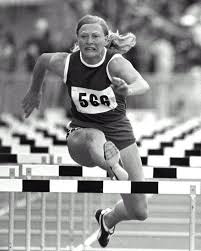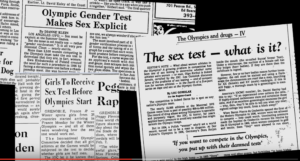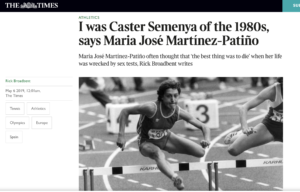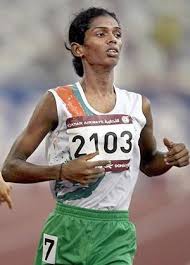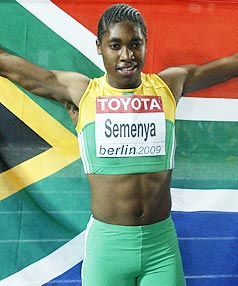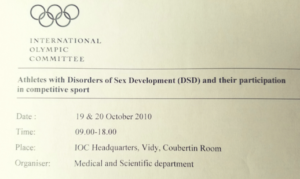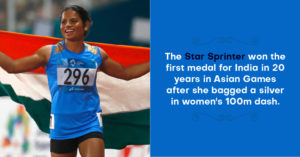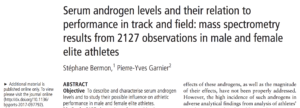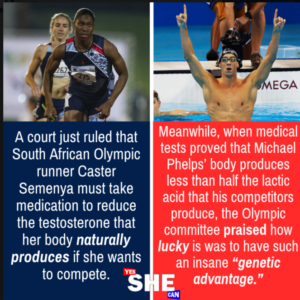Sex Testing Female Assigned Women in Sport: 1950 – Today
As reactions to the Court of Arbitration of Sport’s (CAS) ruling against track star Caster Semenya reveal, many people are unaware that females with XY chromosomes and internal testes exist, and that sporting bodies have allowed them to compete as women, without altering their bodies, since mandatory chromosome testing ended in the ’90’s. Most are also unaware that, since then, testing has continued on a case by case basis, “upon suspicion,” targeting women of color from the global south. This lack of awareness is unsurprising, given that most folks don’t feel directly impacted by these issues. Make no mistake however, saying the IAAF policy is “discriminatory” but that this discrimination is “necessary,” as the CAS ruling does, signals an open abandonment of ethics and morality, and a flagrant abuse of power, which should concern everyone.
This overview examines the restrictive and invasive policies imposed for seventy years as of next year, on women athletes assigned and raised female, by the International Olympic Committee (IOC) and the International Association of Athletics Federations (IAAF), the governing body for international track and field). I use “assigned female” in the overview title because it’s a clear accurate way to describe the experience of athletes like Semenya, whom don’t experience gender related privilege despite identifying as the sex they were assigned at birth. I’ve also limited my overview to polices for women assigned and raised female because I’m not an expert on policies from trans athletes and don’t want to do an injustice to the topic. Note, sporting bodies have been trying to conflate the issues of intersex and trans athletes–which involve almost diametrically opposed situations–because they know confusing people into believing they’re the same is a way to hurt Semenya case. Please don’t help them by doing so yourself.
Lastly, Caster Semenya has always, and continues to, call herself a woman, and I encourage everyone to do the same. The term “variation of sex characteristics” can be used to refer to the specific difference sporting policies are using to target Semenya, and others, if needed.
Sex Testing Female Assigned Women in Sport: 1950 – Today
Since 1950, there have been five different policies for sex verification of female assigned women athletes, and also a short period where no regulations existed for these athletes. They are listed below, with explanations to follow:
- 1950 -1968: Mandatory Sex Verification Via Genital Exams and “Nude Parades”
- 1968 – 1999: Mandatory Sex Verification Via Chromosome Analysis
- 1999 -2015, 5/8/2019 – Today: Case-by-Case Gender Verification Testing “Upon Suspicion”
- 5/1/2011-7/27/2015: Regulations Governing Eligibility of Females with Hyperandrogenism to Compete in Women’s Competition, applied on a Case-by-Case Basis “Upon Suspicion”
- 5/8/2019 – present day: Eligibility Regulations for the Female Classification [Athletes with Differences of Sex Development], applied on a Case-by-Case Basis “Upon Suspicion”
1950 -1968: Mandatory Sex Verification Via Genital Exams and “Nude Parades”
The IAAF recommended sex verification testing of female athletes by their individual nations in 1950, in response to rumors that male athletes, particularly from the Soviet block, were disguising themselves as, and competing as women to win more medals for their nations. These early IOC tests required athletes to undergo mandatory genital exams and visual exams by a group of exclusively or predominantly male inspectors, which came to be known as “nude parades.”
As chronicled in the 2008 Dutch article, “Foekje Dillema” (translated excerpt): “Already in the 1930s there was a lot of gossip about cheating in the women’s competition. In 1950 the International Athletics Union decided to put an end to this. From now on, all participants in the international competitions had to submit a statement from a gynecologist that they were (fully) female. The purpose of the obligation was to remove, I quote “men and hermaphrodites” from the competition. Foekje Dillema was the first victim of this new procedure.” Athletes such as American Maren Seidler and Brit Mary Peters complained, about the highly invasive nature of these tests, as seen below in an excerpt from, “The femininity test: A woman’s first Olympic hurdle” (1976).
1968 -1996: Mandatory Sex Verification Via Chromosome Analysis
Complaints by white American and British female athletes led sporting bodies to abandon the practice of genital exams and “nude parades” as an unethical violation of athletes’ privacy, and to instead begin requiring all females to take chromosome swab tests in order to address continuing concerns that males were competing as women. The IAAF began chromosome testing in 1966, and the IOC at the 1968 Olympics.
Women with XY chromosomes and, in some cases, internal testes–which occurs in a variation of sex characteristics known as Androgen Insensitivity Syndrome (AIS)–were immediately identified by these tests. Many were banned from competition over the decades, including, in 1986, Spanish hurdler Professor Maria José Martínez-Patiño. “I was expelled from our athletes’ residence,” she shared later, “my sports scholarship was revoked… I lost friends, my fiancé, hope, and energy.” She fought her ban and overturned it in 1988, by proving that as a woman with CAIS (Complete Androgen Insensitivity Syndrome), she has no functioning testosterone–0%–and thus could not have the advantage she was being accused of. As a result of Patino’s win, the IAAF discontinued mandatory sex verification testing in 1992, and the IOC in June 1999, with the 1996 Olympics being the last to require mandatory testing.
For clarity, there are other variations of sex characteristics where, unlike CAIS, women with XY chromosomes do possess some level of functioning testosterone. This is true of typical females with XX chromosomes as well. It’s also very significant to note, as I did at the 2010 IOC meeting on this topic, that although women with CAIS have 0% functioning testosterone, they number highly, given their small population, among elite female athletes. Most meeting participants agreed this would be impossible if testosterone confers the “unfair advantage” some claim it does.
1999 – April 2015, May 8, 2019 – Today: Case-by-Case Gender Verification Testing “Upon Suspicion”
After chromosome testing was discontinued, women athletes with XY chromosomes and internal testes could compete without worry of interference–as long as they didn’t have an appearance that placed them “under suspicion.”
This testing criteria places athletes in a very vulnerable, isolated position in a society with little understanding of body diversity in women of color, gender expression, and variations of sex characteristics. In one case, eighteen year old Indian runner Pratima Gaonkar committed suicide, in 2001, shortly after being notified that she would be ineligible to compete. In 2006, Indian runner Santhi Soundarajan was stripped of her silver medal and banned from competition. As Soundarajan shared in an interview, “I was depressed. I felt like I had lost everything. It still hurts. I loved the sport so much. My dream broken, I attempted suicide.”
In 2009, then eighteen years old Caster Semenya was similarly stripped of her gold medal and informed she was not allowed to compete until she underwent invasive gender verification testing. “Since my victory in the female 800 meter event at the Berlin World Championships in August last year,” Semenya stated, “”I have been subjected to unwarranted and invasive scrutiny of the most intimate and private details of my being.” Although these tests are clearly an unethical violation of athletes’ privacy, the athletes’ being violated under the “case-by-case “upon suspicion” policy are almost exclusively women of color from poor, developing nations, and these policies, unlike genital exam/nude parade testing, have not been abandoned, but continue.
May 1, 2011 – July 27, 2015: Regulations Governing Eligibility of Females with Hyperandrogenism to Compete in Women’s Competition, applied on a Case-by-Case Basis “Upon Suspicion”
In response to Semenya’s highly publicized case, the IOC and IAAF held two meetings to review the topic. Reports from the first IOC meeting that, “Athletes who identify themselves as female but have medical disorders that give them masculine characteristics should have their disorders diagnosed and treated,” prompted human rights advocates to petition the IOC. A representative from one the NGOs present at the second October 2010 IOC meeting, reported that athletes and, in turn, top IOC and IAAF officials, had insisted on the adoption of a testosterone based policy, despite ample discussion that there was no evidence to support it. The phrase “women with <em>hyperandrogenism</em>” (which refers to high, naturally occurring functional testosterone levels) was adopted due to successful lobbying for abandonment of the stigmatizing term, “disorders of sex development” (DSD) to describe athletes, and discussion that the term “intersex” was inaccurate as some intersex women are allowed to compete as is (those with the variation CAIS), and not targeted in the new policy.
After these meetings, the IOC and IAAF introduced new regulations in 2011 for women with hyperandrogenism which allowed female athletes to be tested on a case-by-case basis, “upon suspicion,” and banned from women’s competition if they had testosterone levels above 10 nanomoles per liter, unless they took hormones to lower them.
Under this policy, four young female athletes were targeted for testing, described as being from “rural or mountainous regions of developing nations” in a 2013 article written by the doctors they were sent to for testing and “treatment.” For females with variations of sex characteristics, “treatment” often entails full or partial clitoridectomies, vaginoplasty, and/or gonad removal, as infants or minors. Tragically, this is also what happened to the four young athletes, aged 18 through 21, under pressure of saving their livelihoods combined with recommendations given to them by the medical gatekeepers they’d been sent to to undergo invasive testing. As outlined in the journal: “Although leaving male gonads in SDRD5A2 patients carries no health risk, each athlete was informed that gonadectomy would most likely decrease their performance level but allow them to continue elite sport in the female category. We thus proposed a partial clitoridectomy with a bilateral gonadectomy, followed by a deferred feminizing vaginoplasty and estrogen replacement therapy, to which the 4 athletes agreed…”.
In 2014, IOC consultant Dr. Martin Ritzen discussed the fact that the policy targets women from developing countries,, “because in the more developed health care system, patients, or, individuals, that have these inborn errors are diagnosed very early and treated very early.” We note that his description of women with variations in sex characteristics as having “inborn errors,” is consistent with highly stigmatizing framing which the IOC and IAAF have invoked to justify discrimination against these women athletes. Although only hormone therapy was required by the 2011 policy, medical protocols for people with variations of sex characteristics have historically attempted to force our bodies to conform to sex and gender norms by subjecting us to irreversible cosmetic surgical procedures, a practice widely opposed as a human rights violation.
Earlier that same year, Indian sprinter Dutee Chand was banned, but resisted undergoing the medical treatments the 2011 policy required, opting to fight her ban instead, as Maria José Martínez-Patiño had twenty-six years earlier.
July 28, 2015 – May 7, 2019: No regulations for athletes assigned and raised female
In 2015, Indian sprinter Dutee Chand fought and won her case in the Court of Arbitration for Sport (CAS) against her 2014 ban, effectively overturning the 2011 regulations until new regulations were imposed on May 8, 2019. [Note: these were meant to take effect November 1, 2018, but were delayed when Caster Semenya fought their implementation in the Court of Sport (CAS), until the CAS ruled against her.] This is the only period since 1950 that women with variations in sex characteristics have been free to compete as who they are without interference from sporting bodies.
The 2011 Hyperandrogenism Regulations were suspended for two years, giving the IAAF this time period during which to submit further evidence of athletic advantage in order to reintroduce regulations. However, at the 2016 Olympic Games in Rio,European athletes who had competed against Semenya and lost complained in highly publicized tearful interviews, that running against Semenya was unfair–just as some had in Berlin in 2009. In 2017, the IAAF released a paper authored by their own medical staff and published in the British Journal of Sports Medicine, which claimed that women with hyperandrogenism have an unfair advantage over other women.
May 8, 2019 – present day: Eligibility Regulations for the Female Classification [Athletes with Differences of Sex Development], applied on a Case-by-Case Basis “Upon Suspicion”
On April 23, 2018, the IAAF introduced a new policy, which targets “Athletes with Differences of Sex Development” competing in the 400m through mile events, on a case-by-case basis, “upon suspicion,” and disqualifies them if they have functional testosterone levels over 5 nanomole per liter–half the limit of the prior regulations–unless they take hormones to lower their T levels. Notably, the latest policy reinstates the use of DSD in place of “women with hyperandrogenism,” a move which negatively positions women like Semenya as “athletes” rather than “women,” and focuses on their sex characteristics, which is a form of gender discrimination. Women with hyperandrogenism are assigned, raised, and live as females and should not have the privacy of their sex development and anatomy publicly violated by this labelling.
The policy has been widely criticized as targeting Semenya specifically, as it applies only to women with high T competing in her events, and as scientifically unsound as testosterone provides more benefit in power events such as shot put that are not included in the policy. In addition, the 2017 report used to support the policy’s stance on testosterone has been criticized for using faulty data as well as being written by members the IAAF’s own medical staff.
Semenya, like Chand, fought the policy, intended to have taken effect November 1, 2018, in the Court of Sport (CAS), with support from Athletics South Africa (ASA). Dozens of top female athletes also supported Semenya in July, 2018, in an Open Letter to the IAAF urging them to allow Caster to compete in her natural body.
Despite highly visible support, on May 1, 2019, the CAS ruled against her Semenya, stating that the IAAF policy is “discriminatory,” but that such discrimination is “necessary.” This upheld the new “DSD” IAAF policy, which took effect May 8, 2019. In response, the World Medical Association issued a statement that no one, including women athletes with high testosterone, should be forcibly coerced into making such medically unnecessary, potentially very harmful, all encompassing changes to their being. In addition, the decision has been highly criticized as cruel, unusual and amoral, sexist, and in a fantastic essay by Olympian Casey Legler, racist as well. The CAS gave Semenya 30 days to dispute the decision, and on May 13th, Sport minister Tokozile Xasa instructed Athletics South Africa (ASA) to appeal.
As this overview reveals, rather than policies improving over the decades to provide more transparent, equally applied criteria for female assigned athletes to compete as women, policies have become less fairly applied, less transparent, and increasingly specific, enabled by sexism, racism, and discrimination against gender non-conforming women.
